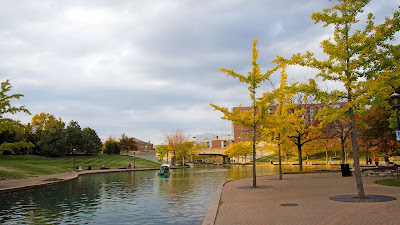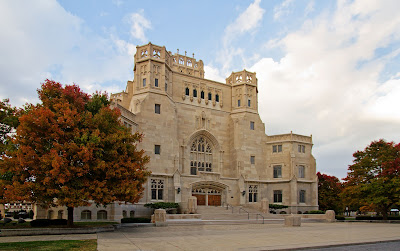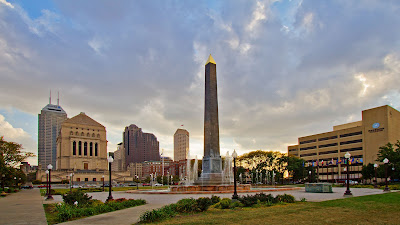Indianapolis was a very pleasant surprise for me. Even though I had been there briefly some years ago, my mental image of the Indiana capital was all wrong. Since Indiana is a rural, farm-oriented state, producing more corn than any state except Iowa, I sort of pictured its capital and largest city as something of a "hick" town. Maybe I expected to see the streets lined with John Deere tractors and the mayor wearing overalls. I'm happy to say I was way off base.
In reality, Indianapolis struck me as a fairly progressive city, one that radiates quality of life. It appears they have more monuments and memorials than any other city of comparable size, other than Washington, DC. Further, the number of downtown parks is very impressive. I also saw lots of restaurants downtown and, for a mid-week evening, plenty of people there to enjoy them. All in all, it was a most pleasant atmosphere for both locals and tourists.
One of my objectives here was Lucas Oil Stadium, home of the Indianapolis Colts. While not a big fan of the Colts, I always want to visit major sports venues and, hopefully, get pictures of the field. In this case, I was unable to get onto the field, despite pleading my case with the young security officer.
 |
| Lucas Oil Stadium | | |
|
As a southern boy, I am always impressed by skywalks found in Northern cities, allowing folks to pass between buildings without walking in the snow.
 |
| Skywalk |
I particularly wanted to see the memorial to the USS Indianapolis, one of the most significant stories of WWII, but not really known that well today. In brief, the "Indy" delivered the first atomic bomb to the Enola Gay's base, from where it was then delivered by Enola Gay to Hiroshima, Japan and began the end of the war. The "Indy" was sent on another mission, without escort, through an area active with enemy subs. Two torpedoes sank her in a matter of minutes. Of 1200 crewmen, 300 were killed by explosions or went down with the ship. The other 900 went into the ocean, where they spent four days among the sharks, while the Navy lost track of the ship and ignored the SOS. Only 317 survived. The greatest indignity was when the skipper of the "Indy" was court martialed in what most consider to be an egregious cover-up by Navy brass.
 |
| USS Indianapolis Memorial |
Gertie (my GPS) had a little trouble finding the memorial because it is located in a park, not at a regular address. The park is a part of a canal that runs through much of the city. Back in the 1830s, there was a plan to dig a 300 mile long canal to connect the Erie Canal to the Ohio River via Lake Erie and the Wabash River. A depression killed the project, but eight miles of canal was completed in Indianapolis. A downtown state park and other green areas have been developed along the sixty foot wide waterway.
The canal has walking/jogging/biking paths, as well as boating in the canal. In addition, there are both commercial and residential buildings, all very tastefully landscaped to blend in with the park environment.
 |
| Pedestrian Bridge |
 |
| Pedal Boat On The canal |
 |
| Fall Foliage |
 |
| Tree-lined Row of Townhomes |
The Scottish Rite Cathedral is one of the largest Masonic buildings in the world, and one of the finest examples of Neo Gothic architecture. Completed in 1929, every dimension of the building is divisible by three, and many are divisible by thirty-three. This reflects the three degrees of Masonry. The building is very popular and hosts many functions, such as weddings, banquets, etc.
 |
| Scottish Rite Cathedral |
 |
| Scottish Rite Cathedral | | |
Veterans Memorial Plaza is another attractive park in the downtown area. It is across the street from the Indiana War Memorial, on the left side of the photo below.
 |
| Veterans Memorial Plaza |
Even the more conventional skyscrapers are on streets lined with colorful trees.
 |
| Downtown Skyscrapers |
Of course, I wanted to see and photograph the state capitol building. One view of it was a reflection in the glass-walled building across the street.
 |
| Reflection of Capitol | | | |
|
Another view was through the colorful trees.
 |
| Indiana Capitol |
The same view taken later that evening, after dark.
 |
| Indiana Capitol At Night |
A few blocks away, Monument Circle highlights the Soldiers and Sailors Monument, completed in 1901. At 284 feet tall, it is just shorter than the Statue of Liberty. The first monument to the common soldier, it is in the exact center of downtown.
 |
| Soldiers and sailors Monument |
Also on Monument Circle, Christ Church Cathedral serves a parish that dates to 1837, although this building was completed in 1857. The church is well known for its Choir of Men and Boys, as well as its Girls Choir.
 |
| Christ Church Cathedral |
One of the most colorful buildings I've seen anywhere is the Murat Shrine, owned by the Shriners. Now used as a theater, it is the largest Shrine temple in North America and the only one in the world with a French name.
 |
| Murat Shrine |
I'll end this with a sunrise taken from a pond in the campground where I stayed in Indianapolis.
 |
| Lake Haven RV Park At sunrise |


















Wonderfully informative post about Indianapolis. And, the photos were beautiful. I'd also pretty much written off Indiana. Might have to stop in Indianapolis next trip through that state.
ReplyDelete